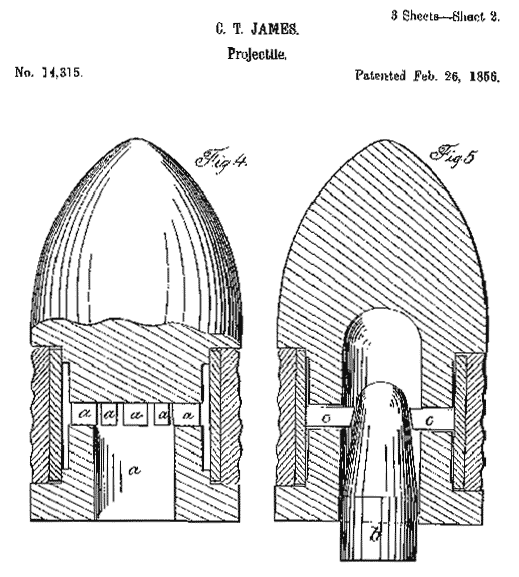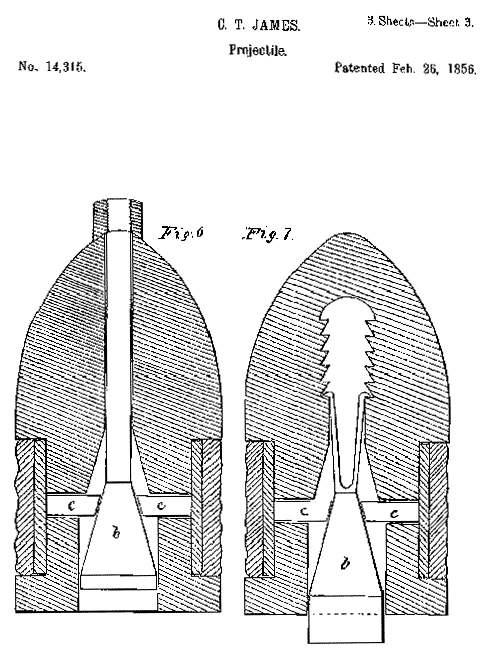


|
To all whom it may concern: Be it known that I, CHARLES T. JAMES, of Providence, Rhode Island, have invented a new and useful Improvement in Projectiles, which has not been known or used before my invention thereof, a full and accurate description whereof is herein contained, reference being had to the accompanying drawings, forming a part of this description. My improvement is in the manner of imparting rotary motion to shot fired from a rifled cannon, and its effect is to give a sufficient degree of rotation to the shot without injuring or clogging the gun, and therein it differs from other devices to accomplish the same object. The idea of forming the shot of some metal which would yield and expand under the pressure incident to the explosion of the charge of powder is well known, and has long been practiced in small-arms with success. The same principle has been tried in great guns by using soft metal bands on the shot, distended by loading or firing, and patents have been granted for devices for effecting the distension; but it is found that the great intensity of heat and the great amount of power exerted in a cannon so affect the soft metal that it adheres to or "leads" the gun, thereby destroying the value of that method for cannon. There is no difficulty in expanding the soft metal to fill the scores of the gun by the act of loading or firing; but the difficulty is that when expanded it is deposited upon the interior surface of the gun and adheres to it with great tenacity. My improvement consists in using fibrous material, instead of a flexible metallic one, and in expanding it into the scores of the gun by the explosive power of the powder when ignited by devices hereinafter described. The best material for this purpose is hemp, spun or woven; but cotton or other fibrous material, or vulcanized india-rubber, or strips of common rubber woven with gum or other fibrous materials, may be substituted with excellent effect. The shot, which is of any of the oblong shapes, is cast with a recess in its cylindrical surface, forming a sort of channel way around its entire circumference. A hole is left or cored out through the shot concentric with its cylindrical surface, opening toward the breech of the gun and reaching as far as the channel or recess described. Into this cylindrical hole other perforations are made, opening into the channel way or recess for the packing, and approaching each other as they approach the central bore, so as to form radii to the circle, like spokes of a wheel. By means of this combination there is a direct communication between the chamber of the gun where the powder is exploded and the channel for the packing, so that when the gas is generated in the chamber it would blow through the holes above described into the channel-way for the packing. If, therefore, this channel-way be filled with hemp packing, either in the shape of spun yarn formed into braid and greased or of woven bands of canvas, and the charge be fired, the packing will be distended against the inside surface of the gun, filling the scores, and thereby controlling the motion of the shot when it is projected. A band of hoop-iron, provided with a clip to keep it from turning, may be first sprung into this channel-way, so as to receive the pressure of the gas so as to press out the packing without bringing it into direct contact with the gas itself, and pins may be placed in the holes leading from the channel-way to the center bore of the shot, and a pointed mandrel be left in the center bore, so that when it is driven forward by the explosive power of the gas it will force out the pins, which enter the center bore, and so distend the packing. This mandrel may be made to pass entirely through the shot and have a nut on its front end, which may be screwed down, so as to draw up the mandrel by the rammer, which should be provided with a nut holder in its bottom end for that purpose. In the accompanying drawings, Figure 1 represents a shot in which only the fibrous packing is used in connection with openings from its interior surface to the chamber of the gun, as shown at letters a a. Fig. 2 shows a transverse section through the shot in the plane of the radial holes, and exhibits the manner in which the communication is made between the gas and the packing. Fig. 3 exhibits the same shot as Fig. 1, excepting that the packing-ring of iron is applied under the fibrous packing. Fig. 4 is a section and side view of that ring. Fig. 5 shows the same shot with pins c c running from the inside of the packing to the mandrel b, which, being pointed, will, when driven in by the explosive power of the gas, drive out the pins which rest upon it and distend the packing. By making this mandrel long enough to rest upon the cartridge or the breech of the gun, it will be driven in by the act of forcing down the shot. Fig. 6 shows the mandrel b extended through the shot and seized at its front end by a nut, which, being turned by a rammer provided with a nut-holder in its extremity, will distend the packing. Fig. 7 shows the mandrel with a self-acting catch to hold it in its place, however tight it may be driven home by the rammer. In using this form the mandrel should project at the base of the shot, so as to rest upon the cartridge. When the shot is driven home, the mandrel will be pressed in and the ratchet hold it fast. It is obvious from the foregoing that while these devices for distending the packing are simple and efficient, many others may be devised upon the same principle of operation which will work well, and which would be equivalent for any of these when used in combination with the fibrous packing. What I claim as my invention, and desire to secure by Letters Patent, is -- 1. The combination of a band of fibrous packing around a cannon-ball with a means of distending it into the scores or rifles of the cannon (without enlarging the shot itself, as is done where it is wholly or partially formed of flexible metal) by the pressure of the explosive gas, substantially as herein described. 2. The combination of a mandrel passing through the shot for the purpose of driving out the pins with a nut for drawing it in, substantially as herein described. 3. The combination of a mandrel entering the shot with a ratchet or equivalent catch for holding it in its place, substantially as described. 4. The combination of any pliable packing-ring surrounding the shot with the openings communicating between its inner surface and the chamber where the explosive gas is generated, for the purpose of communicating the power to distend such packing, substantially as herein described. CHAS. T. JAMES. Witnesses: |


